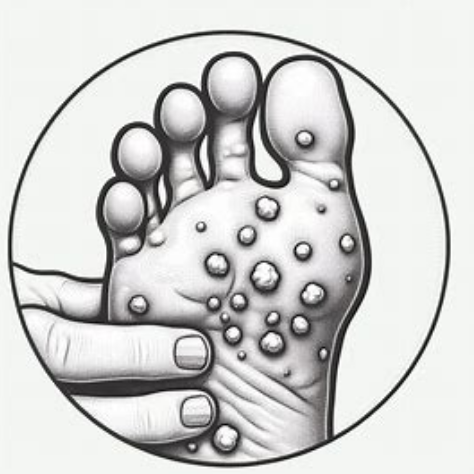
Foot diseases during rainy season
As monsoon arrives, there’s an increased likelihood of certain foot and ankle diseases due to the humid environment and increased water exposure. Here’s a detailed breakdown of these conditions:
1. Tinea Pedis (Athlete’s Foot):
Symptoms: Itchy, scaly rash usually between the toes or on the soles of the feet.
Causes: Fungi thrive in warm, moist environments like shoes and socks that haven’t dried properly.
Prevention: Keep feet clean and dry, wear moisture-wicking socks, and use antifungal powder.
2. Fungal Nail Infection:
Symptoms: Thickened, discolored, or brittle nails.
Causes: The same fungi responsible for athlete’s foot can also infect nails.
Prevention: Keep nails trimmed, avoid going barefoot in public places, and use antifungal nail treatments.
3. Plantar Warts:
Symptoms: Raised, rough patches on the soles of the feet.
Causes: Caused by the human papillomavirus (HPV) entering through tiny cuts or scrapes on the feet.
Prevention: Avoid walking barefoot in public places, keep feet dry, and use protective footwear in shared areas.
4. Blisters:
Symptoms: Fluid-filled sacs on the skin, often caused by friction or moisture.
Causes: Common during monsoon due to wet socks, ill-fitting shoes, or excessive rubbing.
Prevention: Wear well-fitting shoes, use moisture-wicking socks, and keep feet dry.
5. Heel Pain:
Symptoms: Pain under the heel, especially after long periods of rest or walking.
Causes: Plantar fasciitis, inflammation of the tissue connecting the heel bone to the toes, can be aggravated by moisture.
Prevention: Proper arch support, stretching exercises, and wearing cushioned shoes can help prevent this condition.
6. Trench Foot:
Symptoms: Redness, swelling, numbness, or tingling in the feet.
Causes: Prolonged exposure to wet and cold conditions, common among those standing in water for long periods.
Prevention: Keep feet dry and warm, change socks regularly, and avoid prolonged exposure to wet conditions.
7. Corns and Calluses:
Symptoms: Thickened, hardened areas of skin on the feet.
Causes: Friction or pressure, often due to ill-fitting shoes.
Prevention: Wear well-fitted shoes, use padding or insoles, and keep feet moisturized.
8. Bacterial Infections:
Symptoms: Redness, warmth, pain, swelling, and possibly fever.
Causes: Open wounds or cuts that get infected due to exposure to contaminated water or unhygienic conditions.
Prevention: Keep feet clean and dry, cover open wounds, and seek medical attention if you suspect an infection.
9. Gout Flares:
Symptoms: Intense pain, swelling, and redness in a joint, often the big toe.
Causes: Increased humidity and temperature changes can trigger gout attacks in susceptible individuals.
Prevention: Stay hydrated, maintain a healthy weight, and avoid foods high in purines, like red meat and alcohol.
10. Fungal Skin Infections:
Symptoms: Red, itchy, scaly patches on the skin.
Causes: Fungi thrive in moist conditions, making skin infections more common during monsoon.
Prevention: Keep skin clean and dry, avoid sharing personal items, and use antifungal creams.
Remember, proper foot hygiene and wearing appropriate footwear can significantly reduce the risk of these monsoon-related foot and ankle diseases. If you experience any concerning symptoms, it’s essential to seek medical advice promptly. Stay safe and take care of your feet!
